City guides

St Kitts Travel Guide
Known formally as Saint Christopher Island, Saint Kitts was named by Christopher Columbus on landing there in 1493. But it was not until it became an English colony in 1623 that its name was shortened to Saint Kitts.
A lush and verdant island, Saint Kitts is the larger of the twin-islands that make up the country and is more developed than Nevis. However, neither has succumbed to tourist trappings, remaining an unassuming and uncrowded destination that is a true gem in the Caribbean crown.
Dominated by an extinct 3,792ft (1,156m) volcano, the island is covered in green vegetation and sugar cane fields, and is ringed by sandy coves, coral reefs, and clear waters. Most beaches to the north are black and sandy due to the volcanic nature of the land. But southern beaches such as Frigate Bay, Banana Bay, Sand Bank Bay, and Cockleshell Bay are deserted stretches of fine white sand.
There's more to Saint Kitts than natural splendour and beaches. A history of slave revolution and colonialism during the 18th century left the island with a rich heritage of architecture, as well as sites such as the impressive Brimstone Hill, constructed to protect the wealthy of the island.
During the heyday of the sugar industry, Saint Kitts boasted 68 sugar plantations. The oldest and richest colony in the Caribbean, its prosperity finally ended with the abolition of slavery and its once-prolific factories and windmills lie in ruins among abandoned estates.
Things to do in St Kitts
The little island of Saint Kitts offers an unexpected wealth of sightseeing activities for visitors. Most will be perfectly content without moving beyond the gorgeous beaches. Top attractions within Basseterre include the Circus, Independence Square, and the Treasury Building, housing the National Museum. The UNESCO-listed Brimstone Hill Fortress sits above the city and is well-worth the climb.
Those capable of tackling a fairly strenuous climb are rewarded for hiking up Mount Liamuiga, the island's dormant volcano. There are also some good walking trails through the rainforest, protected in the national park that covers roughly a quarter of the island.
Those who prefer not to break a sweat can take the scenic drive to the views from Bloody Point, the site of the colonial massacre of 2,000 Carib Indians. Another way to tour Saint Kitts is to board the popular Scenic Railway, which makes a three-hour circuit around the picturesque island. Other attractions include Romney Manor, a 17th-century sugar estate, and the Fairview Great House and Gardens, a colonial mansion dating back to 1701.
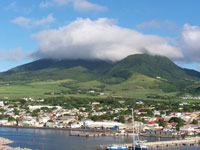
Basseterre
The capital of Saint Kitts and Nevis, Basseterre is one of the oldest towns in the eastern Caribbean. Founded in 1627, it retains a certain architectural charm from its period of British and French colonisation. Basseterre is located on the southwestern coast of St Kitts island and is still one of the chief commercial depots of the Leeward Islands. It is the most common entry point to Saint Kitts and Nevis for travellers arriving by both air and sea. The town has a rather tragic history, punctuated by colonialism, battles, fires, earthquakes, and hurricanes, though historic buildings are spread throughout, with many of the old structures surviving these perils to the present day.
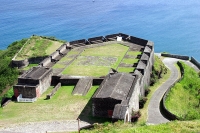
Brimstone Hill Fortress
Nicknamed the 'Gibraltar of the West Indies', the striking Brimstone Hill Fortress sits atop an 800-foot (244m) rise and is protected by 49 guns and immense walls. Built largely by African slaves, it took nearly ten decades to complete since construction first began in 1690. The scale and grandeur of this UNESCO World Heritage Site is representative of the historic importance of Saint Kitts during the 17th and 18th centuries. Today, the complex affords incredible views from its commanding position and houses a small museum.
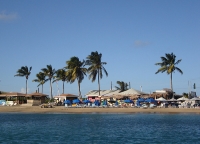
Frigate Bay Peninsula
If Saint Kitts can be described as a tennis racquet-shaped island, the Frigate Bay Peninsula is the narrow handle stretching down towards Nevis. It connects the racquet head to the widened end of the handle to the southeast. The peninsula is unique in that it offers beaches on both the Atlantic and Caribbean coasts. South Frigate Bay on the leeward side offers calm waters ideal for swimming, snorkelling, and a variety of water sports activities. Alternatively, North Frigate Bay on the Atlantic Coast is battered by waves perfect for bodysurfing and is one of the most scenic beaches on the island. As a result, it has also attracted most of the resort and hotel development along the coast.
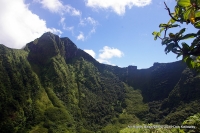
Mount Liamuiga
The highest point on Saint Kitts, Mount Liamuiga is a dormant volcano topped by a 0.6-mile (1km) wide crater lake. Formerly called Mount Misery, the name Liamuiga means 'fertile land' in the native Kalinago language. The slopes of the mountain are covered in farmland and lush tropical rainforest, and are popular places for hiking in Saint Kitts. Guided hikes usually start from Belmont Estate in the village of St Paul's and go up to the summit, which has panoramic views of the Caribbean, including the islands of St Barths, St Martin, Antigua, and Nevis.
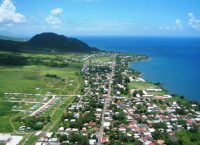
Sandy Point
Sandy Point Town is the second-largest on Saint Kitts, with a population of just more than 3,000 people in the surrounding area. Thought to be the original landing point for English explorer Sir Thomas Warner in 1623, Sandy Point was the commercial centre of the island until the 18th century, when most business was moved to Basseterre. These days, Sandy Point is an industrial centre and tourist attraction, located at the entrance to Brimstone Hill National Park. There are some excellent beaches around Sandy Bay, including the shiny black sand beach of Pump Bay, offering good scuba diving and snorkelling opportunities, and Belle Tete, which is near the La Valle estate.
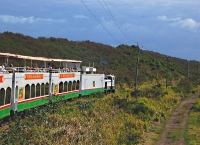
Scenic Railway
One of the most popular tourist activities on the island, the St Kitts Scenic Railway is a must for first-time visitors to the Caribbean. It is a fantastic way to experience the beautiful scenery of the island, as well as its history of a major sugar producer in the 17th and 18th centuries. The St Kitts Scenic Railway takes visitors on a three-hour tour of the island, following a 30-mile (48km) circular track. The narrow-gauge train is unique in that it has two levels: an open-air observation deck on the top offering panoramic views, and an air-conditioned parlour below, where complimentary beverages are served throughout the trip. As the train rolls by sugar cane fields, traditional villages, and great sights such as Brimstone Hill Fortress, friendly tour guides share anecdotes about the island and snippets of its colonial history. Cruise passengers should note that tickets for the Scenic Railway can be booked while on board most cruise ships.
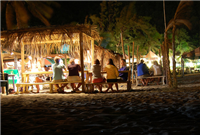
The Strip
The Strip is the area immediately surrounding Frigate Bay. It is the beating heart of the island when it comes to nightlife and entertainment options. However, visitors should not expect neon lights or chic buildings. Rather, a closer guess would be a series of unpretentious beach shacks located a mere stone's throw from the ocean. Visitors can rest assured that what the Strip lacks in glitz, it more than makes up for in spirit, with numerous bars and clubs offering live music, DJs, fire-eating performances, bonfires, and a steady supply of cold rum cocktails to fuel dance moves. Although restaurants and bars can be found on some of the most popular beaches, the Strip is the natural entertainment hub for those in search of fun on St Kitts.
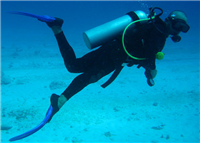
Dive Sites
As with all Caribbean destinations, one of the most popular things to do on Saint Kitts and Nevis is head out for some scuba diving or snorkelling. The calm, clear waters of the Caribbean Sea, not to mention its spectacular coral reef formations and abundant marine life, make it a wonderful diving and snorkelling destination for beginners and experts alike.
For those new to diving, Monkey Shoals and Friars Bay Reef provide a gentle introduction to the undersea wonders of Saint Kitts and Nevis, with plenty of reputable diving companies offering full training and guided excursions into the depths. For intermediate-level divers, Sandy Point on Saint Kitts is a National Marine Park known for its beautiful coral heads and colourful sea life. Those who prefer the excitement of wreck-diving can explore the remains of ships such as River Taw, M.V. Talata, and the recently sunk Corinthian. Experienced divers will enjoy the challenge of Nags Head's strong currents and Aquarium, famous for its range of tropical fish.
St Kitts and Nevis travel info
Electricity
Electrical current is 230 volts, 60 Hz, but a 117-volt supply is available in most hotels. Round three-pin plugs and three-pin rectangular blade plugs (as in the UK) are in use.
Language
English is the official language.
Money
The official currency is the East Caribbean Dollar (XCD), which is divided into 100 cents. It is tied to the US dollar at a rate of US$1 to XDC2.70. Most businesses accept US dollar notes as payment, but change is given in XCD. Major credit cards are widely accepted, and major currencies can be exchanged at banks, with US dollars the cheapest to exchange. Most banks are closed on weekends, but provide 24-hour ATM services.
Tipping
A 10 percent service charge is usually included in hotel and restaurant bills. Otherwise, it's customary to leave 10 to 15 percent of the bill, depending on the service. Taxi drivers can also receive a tip of around 10 to 15 percent.
Health
All eligible travellers should be up to date with their COVID-19 vaccines, and vaccinations for hepatitis A, hepatitis B and typhoid are recommended. A yellow fever vaccination is required for travellers who are over the age of one and are visiting from a country where there is a risk of transmission. Dengue fever can occur throughout the year and cases of Chikungunya virus have been reported, so visitors should take steps to avoid being bitten by mosquitoes. The main government hospital can cope with many types of treatment but serious cases may require emergency evacuation. Medical treatment can be expensive; visitors should have adequate travel health insurance and accessible funds to cover the cost of any medical treatment and repatriation.
Safety
Although most visits to the islands are trouble-free, visitors should still guard against robbery and other crimes of opportunity. Valuables should be left in hotel safes where possible and remote places, particularly beaches, should be avoided, especially after dark. Travellers should take great care at all times when swimming as currents can be deceptively strong and not all beaches have lifeguards or warning flags. Hurricane season normally runs from June to November.
Local customs
Local attitudes towards the LGBT community are mostly conservative throughout the Caribbean. Public displays of affection such as hand-holding or kissing between same-sex couples are uncommon; certain homosexual acts are illegal. Wearing camouflage clothing is illegal and the penalties for drug-related offenses are severe.
Doing business
Business in Saint Kitts and Nevis is conducted in a relatively informal manner, but fairly formal dress is expected despite the heat. Handshakes for both men and women are the common form of greeting, and business cards should be exchanged immediately after being introduced. Business hours are generally 8am to 4pm Monday to Friday, with an hour taken at lunch.
Duty free
Travellers over the age of 18 may import 200 cigarettes or 50 cigars or 250g tobacco, and 1.5 litres of wine or spirits without paying customs duty.
Communications
The international dialling code for St Kitts and Nevis is +1 869. Hotels, cafes and restaurants offer free WiFi; travellers can purchase local prepaid SIM cards for unlocked phones.
Passport & Visa
Although a maximum stay of either three or six months is indicated in official requirements, immigration officials will decide how long visitors are legally allowed to stay in St Kitts and Nevis upon arrival. Visitors are recommended to hold confirmed return or onward tickets, all documents needed for next destination and sufficient funds to cover their stay. As part of the Western Hemisphere Travel Initiative (WHTI), all travellers moving between the United States and Canada, Mexico, Bermuda, and the Caribbean region are required to present a passport or other valid travel document to enter or re-enter the United States. If departing from the USA a valid passport will be required by immigration authorities. It is highly recommended that travellers' passports have at least six months' validity remaining after the intended date of departure from their travel destination. Immigration officials often apply different rules to those stated by travel agents and official sources.
Entry requirements
U.S. citizens must have a valid U.S. passport to enter Saint Kitts and Nevis. No visa is required for stays up to 90 days if travellers have an onward or return ticket, confirmation of accommodation, and can produce evidence of their ability to maintain themselves.
UK passports should be valid for a minimum period of six months from the date travellers arrive. A visa is not required, though UK travellers will be granted a specific period to stay. Those who wish to stay longer must apply for an extension of stay through the St Kitts and Nevis Immigration Department.
Canadians require a passport valid for at least six months beyond period of stay. A visa is not required for a stay of up to six months.
Australians require a passport valid for at least six months beyond period of stay, but no visa is necessary for stays of up to three months.
South Africans require a passport valid for the intended period of stay, but no visa is required for visits of up to 90 days.
Irish nationals require a passport valid for the intended period of stay, but no visa is required for a stay of up to three months.
New Zealand nationals require a passport valid for the intended period of stay, but no visa is required for a stay of up to 90 days.
Useful contacts
Department of Tourism, Basseterre, St. Kitts: +1 869 465 4040 or www.stkittstourism.kn
Emergencies: 911Embassies / consulates in other countries
St Kitts and Nevis Embassy, Washington DC, United States: +1 202 686 2636.
St Kitts and Nevis High Commission, London, UK: +1 020 7937 9718.
High Commission for the Eastern Caribbean States, Ottawa, Ontario: +1 613 236 8952.
Embassies / consulates in St Kitts and Nevis
United States Embassy, Bridgetown, Barbados (also responsible for St Kitts-Nevis): +1 246 227 4000.
British High Commission, Bridgetown, Barbados (also responsible for St Kitts and Nevis): +1 246 430 7800.
Canadian High Commission, Bridgetown, Barbados (also responsible for St Kitts-Nevis): +1 246 429 3550.
Australian High Commission, Port of Spain, Trinidad and Tobago (also responsible for St Kitts-Nevis): +1 868 822 5450.
South African High Commission, Kingston, Jamaica (also responsible for St Kitts-Nevis): +1 876 620 4840.


